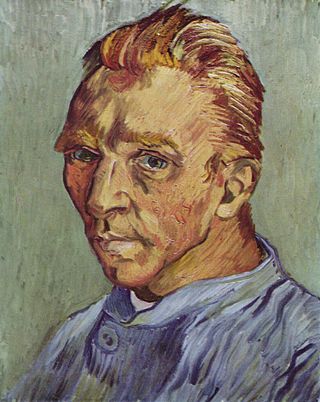
August Robert Ludwig Macke was a German Expressionist painter. He was one of the leading members of the German Expressionist group Der Blaue Reiter. He lived during a particularly active time for German art: he saw the development of the main German Expressionist movements as well as the arrival of the successive avant-garde movements which were forming in the rest of Europe. As an artist of his time, Macke knew how to integrate into his painting the elements of the avant-garde which most interested him. Like his friend Franz Marc and Otto Soltau, he was one of the young German artists who died in the First World War.
The year 1887 in art involved some significant events.

The Elephant Celebes is a 1921 painting by the German Dadaist and surrealist Max Ernst. It is among the most famous of Ernst's early surrealist works and "undoubtedly the first masterpiece of Surrealist painting in the de Chirico tradition." It combines the vivid dreamlike atmosphere of Surrealism with the collage aspects of Dada.

Carl Grossberg, originally Georg Carl Wilhelm Grandmontagne was a German painter associated with the New Objectivity movement; best known for his urban and industrial scenes.

Landscape with Cows and Camel is a 1914 oil-on-canvas painting by German Expressionist painter August Macke. It is drawn in an Expressionist style influenced by Orphism. It is now housed at Kunsthaus Zürich, Zürich.

Dutch Post-Impressionist painter Vincent van Gogh painted a self-portrait in oil on canvas in September 1889. The work, which may have been Van Gogh's last self-portrait, was painted shortly before he left Saint-Rémy-de-Provence in southern France. The painting is now at the Musée d'Orsay in Paris.

Self-portrait without beard is an 1889 oil on canvas painting by the post-impressionist artist Vincent van Gogh. The picture, which may have been Van Gogh's last self-portrait, was painted in September that year. The self-portrait is one of the most expensive paintings of all time, selling for $71.5 million in 1998 in New York City. At the time, it was the third most expensive painting ever sold.

The Prayer book of Stefan Lochner is an illuminated manuscript attributed to the German artist Stefan Lochner. Dated to the early 1450s, the Book of hours consists of 235 leaves, each folio measuring 108 x 80mm. The extent of Lochner's involvement is debated; workshop members were probably heavily engaged in its production. However, his style, or at least that of his followers, can be detected in the overall layout; the colourisation, vivid and harmonious flowers in the borders, and the delicate treatment of the foliage are all characteristic of his style.

The Faux Pas is a 1716-1718 oil on canvas painting by Antoine Watteau, now in the Louvre, which was left by Dr La Trujillo in 1869. It draws on north European works such as The Village Fête by Rubens, now also in the Louvre.

Bernhard Koehler was a German industrialist and art collector.

Portrait with Apples, also known as Elisabeth with Apples, is an oil-on-canvas painting executed in 1909 by the German Expressionist painter August Macke. It shows his wife Elisabeth Gerhardt and was created shortly after their wedding. Macke had studied the work of the Fauve artists during his honeymoon in Paris, and the painting shows their influence. It marks the beginning of his public artistic appreciation. The work belongs to the collection of the Städtische Galerie im Lenbachhaus, in Munich.

Promenade is an oil-on-cardboard painting by the German artist August Macke, executed in 1913. It is held at the Städtische Galerie im Lenbachhaus in Munich. Chronologically, it is the first of the paintings that he created after moving to Hilterfingen in Switzerland.

Woman with Umbrella in Front of a Hat Shop is an oil-on-canvas painting executed in 1914 by the German painter August Macke. It depicts a woman peeking into a hat shop, painted in an Expressionist style. The painting is in the collection of the Museum Folkwang in Essen.

Lady in Green Jacket is an oil-on-canvas painting by German artist August Macke, executed in 1913. It is held in the Museum Ludwig in Cologne.

Fox, also known as Blue and Black Fox or Blue Fox, is an oil on canvas painting by Franz Marc, from 1911. It is part of the collection of the Von der Heydt Museum in Wuppertal.

Large Bright Showcase is an oil-on-canvas painting by the German artist August Macke, executed in 1912. It is held at the Sprengel Museum in Hanover.

A Couple also known as The Engaged Couple or Alfred Sisley and his Wife, is an oil-on-canvas painting by the French artist Pierre-Auguste Renoir (1841–1919), created around 1868 during his early Salon period at a time when he focused on thematic works about couples. It was acquired by the Wallraf–Richartz Museum in 1912.

At the Theatre , also known as The First Outing, is an oil-on-canvas painting by the French artist Pierre-Auguste Renoir, created around 1876–1877. It was acquired by the National Gallery in 1923. It shows two beautiful young women in what appears to be an opera box, looking down into the audience in the box below them.

The Braid, also known as Femme se coiffant, La Natte, or Girl Braiding Her Hair, is an oil-on-canvas painting by the French artist Pierre-Auguste Renoir, created between 1886 and 1887 during his so-called dry or Ingres period.



















